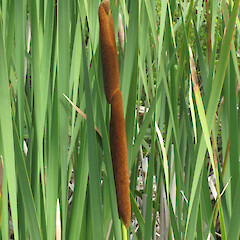Typha orientalis
Common name
raupō, bullrush
Synonyms
Typha muelleri Rohrb.
Family
Typhaceae
Flora category
Vascular – Native
Endemic taxon
No
Endemic genus
No
Endemic family
No
Structural class
Herbs - Monocots
NVS code
The National Vegetation Survey (NVS) Databank is a physical archive and electronic databank containing records of over 94,000 vegetation survey plots - including data from over 19,000 permanent plots. NVS maintains a standard set of species code abbreviations that correspond to standard scientific plant names from the Ngä Tipu o Aotearoa - New Zealand Plants database.
TYPORI
Chromosome number
2n = 60
Current conservation status
The conservation status of all known New Zealand vascular plant taxa at the rank of species and below were reassessed in 2017 using the New Zealand Threat Classification System (NZTCS) – more information about this can be found on the NZTCS website. This report includes a statistical summary and brief notes on changes since 2012 and replaces all previous NZTCS lists for vascular plants.
Please note, threat classifications are often suggested by authors when publications fall between NZTCS assessment periods – an interim threat classification status has not been assessed by the NZTCS panel.
- Conservation status of New Zealand indigenous vascular plants, 2017 . 2018. Peter J. de Lange, Jeremy R. Rolfe, John W. Barkla, Shannel P. Courtney, Paul D. Champion, Leon R. Perrie, Sarah M. Beadel, Kerry A. Ford, Ilse Breitwieser, Ines Schönberger, Rowan Hindmarsh-Walls, Peter B. Heenan and Kate Ladley. Department of Conservation. Source: NZTCS and licensed by DOC for reuse under the Creative Commons Attribution 4.0 International licence.
2017 | Not Threatened | Qualifiers: SO
Previous conservation statuses
2012 | Not Threatened
2009 | Not Threatened
2004 | Not Threatened
Distribution
Indigenous. Kermadec Islands group (Raoul Island only), North and South Islands. Deliberately naturalised on the Chatham Islands by Maori. Present also in Australia, Malaysia, Indonesia and the wider western Pacific
Habitat
Coastal to lowland in fertile wetlands, on the margins of ponds, lakes, slow flowing streams, and rivers. Less frequently found on the margins of low moor bogs. Occasionally found in muddy ground within industrial areas.
Wetland plant indicator status rating
Information derived from the revised national wetland plant list prepared to assist councils in delineating and monitoring wetlands (Clarkson et al., 2021 Manaaki Whenua – Landcare Research Contract Report LC3975 for Hawke’s Bay Regional Council). The national plant list categorises plants by the extent to which they are found in wetlands and not ‘drylands’. The indicator status ratings are OBL (obligate wetland), FACW (facultative wetland), FAC (facultative), FACU (facultative upland), and UPL (obligate upland). If you have suggestions for the Wetland Indicator Status Rating, please contact: [Enable JavaScript to view protected content]
OBL: Obligate Wetland
Almost always is a hydrophyte, rarely in uplands (non-wetlands).
Detailed description
Stout summer green, rhizomatous, colonial, usually emergent perennial herb up to 3 m tall. Rhizome to 40 mm diameter, fleshy, covered in numerous scale leaves, usually submerged in water or mud. Leaf-sheath often > 300 mm long; 1-3 m long, 10-30 mm diameter, dull green to grey-green, lamina linear-lanceolate to lanceolate, more or less plano-convex at base, pith spongy. Peduncle usually < leaves, up to 15 mm diameter. Inflorescence 300-500 mm long, the female part up to 25 mm diameter, the male portion narrower, and either continuous with or more or less separated from the female. Bracteoles in male portion more numerous than stamens, more or less equal to anthers, proximally narrow-linear, broader at tip and there variously laciniate, arising directly on axis and remaining more or less curled up after flowers fall. Male flower sessile to subsessile filaments at first shorter than anther-width, elongating later; anthers 1-3, tipped with blunt extension of connective; pollen clear yellow, grains single. Bracteoles in female part very few, absent from many flowers, more or less equal to gynophore hairs, filiform except for a few-celled expansion at apex. Female flowers much smaller than male, several grouped on proximal part of a short compound pedicel. Ovary at flower almost sessile, narrow-elliptic; style long, slender; stigma broader, spathulate, more or less concave; gynophore hairs extremely numerous, barely reaching base of stigma, stiff, filiform, very narrowly clavate at apex. Gynophore elongating at fruit 1-2 times style-length, hairs becoming confined to proximal third of gynophore and in groups or more or less whorled; persistent stigmas brown. Carpodia oblong-obovate, apices just projecting between the hairs. Seed 1.2 mm long, cuneate at base, truncate at apex, yellow.
Similar taxa
Typha latifolia L. has been found in cultivation in New Zealand it differs from T. orientalis by its somewhat wider, flat, pale greyish-green leaves, very dark brown to black erect flower spikes, and one-seeded fruits up to 10 mm long, each with hairs rising near the base, and chromosome number (2n = 30 cf. 2n = 60). Typha domingensis Pers. has also been reported from New Zealand. It differs from T. orientalis by its narrower leaves and much narrower inflorescences and by its chromosome number (2n = 30 cf. 2n = 60).
Flowering
December - February
Flower colours
Yellow
Fruiting
March - June
Propagation technique
Easily grown from fresh seed and division of established plants. Excellent in large ponds and dams but regarded by some as an aggressive weed.
Etymology
typha: From the Greek name for this plant
orientalis: From the Latin orientale, meaning ‘eastern’ but sometimes also translated as ‘from the Orient’.
Attribution
Description adapted from Moore and Edgar (1970).
References and further reading
Mason, R., Moar, N.T. 1951. Typha in N.Z. Wellington Botanical Society Bulletin, 24: 6-9
Moore, L.B.; Edgar, E. 1970: Flora of New Zealand. Vol. II. Government Printer, Wellington.
















